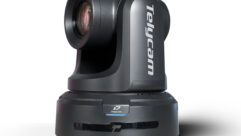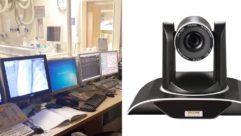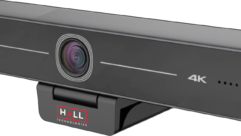Telemedicine and AV
Oct 13, 2010 1:59 PM,
Provided by InfoComm International
Despite a wobbly economy, the U.S. health care sector has seen increasing demand, resulting in doctor shortages and longer wait times at offices, hospitals, and emergency rooms. Older people, with a higher incidence of injury and illness, will become a higher percentage of the population between 2010 and 2018.
Telemedicine has emerged as a means to improve access to medical specialists and facilitate more efficient communication between doctors and patients. At the heart of telemedicine lies AV and IT technology working in tandem for the benefit of all parties. Videoconferencing, transmission of still images, e-health (including online patient portals), remote monitoring of vital signs, continuing medical education, and nursing call centers are all considered part of telemedicine and telehealth.
Certain segments within the health care industry, such as those with bilateral interaction or that rely on visual cues, have quickly adopted videoconferencing as their telemedicine medium. Those include psychiatry, dermatology, radiology, neurology, dentistry, pathology, and cardiology.
Telemedicine is based on three kinds of videoconferencing systems: standard videoconferencing systems for use in doctor’s office or for medical education, purpose-built telemedicine carts equipped with videoconferencing capabilities, and unmanned robotic systems that are steered by medical practitioners from remote offices.
“The physician consult has morphed from a phone call to a video chat,” says Dr. Jay H. Sanders, president and CEO of The Global Telemedicine Group and a physician who is known as the “Father of Telemedicine” for his accomplishments, such as establishing the first statewide telemedicine system in 1991. “The technology has changed radically, from having to build a system ourselves to now being able to buy a robust conferencing system off the shelf.
“The first step in telemedicine technology is using videoconferencing, and it is still a very effective component of multimodality capability. Face-to-face interaction benefits the relationship-building and the transfer of expertise from the specialist to the regional hospital, for example. It’s also important for continuing education for the physician. With more access to a specialist, a doctor’s need for a consult goes down because they’ve gained the knowledge in how to treat the problem.”
For Dr. Keith Vrbicky, a practicing physician and founder of telemedicine services provider American Educational Telecommunications (AET), the technology challenges have changed since he started his company in 1984. “We used ISDN lines at that time, which were expensive. There’s been a sea change in AV technology that enables affordable delivery of telemedicine applications to both urban and rural locations,” he says. “Hurdles to telemedicine adoption include nonreimbursement by insurance companies for the consult time and physicians who are hesitant to use the technology.”
“Videoconferencing enables a single doctor to extend his reach to cover multiple hospitals at once. The traditional model of having a local medical specialist onsite is inefficient. A doctor using videoconferencing can achieve twice the number of consults in a 12-hour period than a specialist onsite. Videoconferencing is the key component,” says Dr. Joe Peterson, board-certified physician and CEO of Specialists on Call, a firm that provides emergency telemedicine consultations 24/7 to hospitals using videoconferencing technology.
Physicians who work with Specialists on Call must use the company’s sanctioned videoconferencing systems in the appropriate environment. “Our doctors are not allowed to use Skype on their laptop for a consult. Patients often divulge sensitive medical information, so you can’t have the doctor sitting at a coffee shop or at the country club,” Peterson says.
Sanders says that telemedicine and videoconferencing are making a big difference to rural communities where the hospital acts to stabilize the socio-economic fabric of the area. “The hospital is usually the top employer, so when they close, the area suffers. There is a decreasing bed census due to the lack of specialists so they have to discharge you and the problem worsens,” he says. “Telemedicine is also reaching into the workplace. Employers forget that they have telemedicine systems in their office already. They just need an open RS-232 port on their videoconferencing system to plug in any number of medical devices like a stethoscope or blood pressure monitor. Workers can save on productivity by doing routine checks without leaving work.”
According to Sanders, the benefits of telemedicine are clear. “Studies have shown that patients are more compliant when they see the doctor face-to-face; their attention span goes up,” Sanders says. “Doctor and patient are able to communicate in an intuitive way using videoconferencing, and there’s no wait at the doctor’s office. Telemedicine increases convenience and reduces travel cost for the patient.”
Telemedicine and AV
Oct 13, 2010 1:59 PM,
Provided by InfoComm International
The Future of Telemedicine Technology
Vrbicky thinks that the next evolution in telemedicine is mobile solutions, like rolling carts, that bring telemedicine to rural communities that otherwise have no access. “Mobile solutions will have a big impact in nursing homes and in-home health services as well,” he says. “It’s dangerous and costly to transport nursing home patients to the hospital, so instead the physician can remotely come to them.”
Vrbicky added that other telemedicine applications will include the use of wireless biosensors and their use in patients with chronic illnesses and home care.
Meanwhile, Peterson says that refinement of current offerings is the next evolution to telemedicine. He recently evaluated a rolling cart with a keyboard 36” from the ground. “A nurse would have to sit or bend over to use it, which is inconvenient since chairs are scarce in a hospital,” he explains.
“The next revolution in telemedicine is cheaper and more reliable technology, like Apple’s FaceTime chat over the iPhone. Everything is in the smartphone,” says Sanders. “Phones will have computing power so people can wear health sensors and have the results analyzed by their phones. The phone can send an alert to the physician if the data is outside the normal values.”
The prominence of telemedicine and videoconferencing will grow as bandwidth improves across the U.S. The Federal Communications Commission’s National Broadband Plan specifically addresses health care as a prime topic.
This is a summary of InfoComm Special Report Telemedicine and AV. To view to the full report, please visit www.infocomm.org/specialreports.










